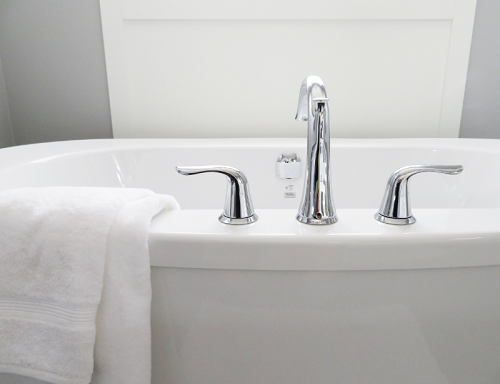Filling a bathtub is a simple task that many engage in regularly, but it can be time-consuming. Some people also worry about the water bill, hence the question, “How long does it take to fill a bathtub?”
Well, there isn’t a straightforward answer, as several factors come into play. First off, bathtubs come in different sizes. This, along with water pressure, faucet flow rate, water temperature, and mixing, will affect how fast a tub fills.
That said, you should be able to fill an average-sized bathtub within 10 minutes. Of course, this is possible with proper plumbing and water pressure. Don’t panic if your tub takes longer to fill; you can do a couple of things to speed up things. Keep reading to learn how long it takes to fill a bathtub; what determines the time, and other related questions.
How Fast Should a Tub Fill?
A bathtub faucet, the output device through which water flows to fill a tub, typically runs at 4 to 7 gallons per minute (15-26 liters per minute). And the average bathtub holds 40-60 gallons (151-227 liters) of water. Using simple mathematics, filling the bathtub will take around 5 to 10 minutes.
Remember that these volumes are for a filled tub, just below the overflow, and people don’t fill the bathtub to the top. On average, people use 35 gallons of water for a bath, translating to less filling time.
As mentioned earlier, the rate at which bathtubs fill will vary depending on the size and shape of the tub, water pressure, and several other plumbing conditions.
Here are common bathtub sizes and the time it takes to fill.
| Type | Bathtub volume (gallons) | Flow rate | Filling time (minutes) |
| X-Small | 30 | 4 to 7 gpm | 5 |
| Small | 40 | 4 to 7 gpm | 6.5 |
| Medium | 60 | 4 to 7 gpm | 10 |
| Large | 80 | 4 to 7 gpm | 13 |
| X-Large | 100 | 4 to 7 gpm | 16.5 |
Remember that we have used a specific water flow rate for this computing. You can expect a different filling time if your faucet produces a different water flow rate. Some tub fillers feature an impressive 10 gpm flow rate, thus allowing you to fill the tub much faster (approximately less than 4 minutes).
What if Your Bathtub Takes Forever to Fill
You may have noticed that your bathtub takes longer than our computations above. Well, there are several possible causes for this, such as:
Low Water Pressure
A drop in your water pressure can be due to several reasons. A common one is the time of day you use your bathtub. Usually, in the mornings and evenings, when everyone is having a shower/bath, water demand is high, and the pressure can be low. Therefore, the water flowing from your bathtub faucet can be lower than usual, thus taking longer to fill the tub.
Low water pressure can also be due to issues in your plumbing, including clogged pipes, old worn-out pipes, narrow pipes, and leaks.
Clogged Appliances
With time, debris and mineral deposits from water build inside the water pipes and faucets, causing blockage and disrupting the water flow. This, in turn, lowers water pressure. The good news is you can resolve this problem by regularly cleaning these components using effective cleaning solutions like vinegar or CLR remover.
Additionally, your water system is likely connected with several valves in place to keep the system working effectively. If any valves are clogged, even partially, it can affect the water pressure. Also, check the main shut-off valve and the water meter for any blockages or leaks to ensure they’re not causing low water pressure.
Faulty or Worn-Out Pipes
If you live in an older house, chances are the pipes are old too. Similarly, there’s a higher chance that the pipes are worn-out, corroded, or damaged, hence unable to allow smooth water flow to your bathtub and other areas of the house. If that’s the case, you may need to replace the old pipes.
Faulty or worn-out pipes can also cause leaks, affecting water flow and pressure to your bathtub. These leaks can also lead to more serious problems in your plumbing system, so it’s best to locate and resolve the problem immediately.
Narrow Pipes
Narrower pipes can cause low water pressure when using your bathtub. This problem is common in older properties as modern houses tend to have wider pipes.
The Water Mixing Valve Is Worn Out
The mixing valve is responsible for mixing cold and hot water to deliver tempered water to the bathtub faucet. This valve can become loose or stuck over time, thus causing water pressure and temperature problems.
Faulty Water Pressure Regulator
This component ensures the water pressure stays within a safe range (around 45 to 60 PSI). Therefore, if it becomes faulty or worn out, it can cause the water pressure in your home to be too low or high.
Why and How to Get More Water Pressure in Your Bathtub?
Low pressure can reduce water flow in your bathtub, thus taking a long time to fill. Secondly, a slow flow can lead to water line problems. Additionally, low-flow faucets can create an unpleasant bathing experience as the water might have cooled off by the time it’s filled. A higher flow will fix this problem by filling the tub quickly and keeping a consistent temperature.
The good news is there are numerous ways to increase water pressure in your bathtub. Depending on what the cause is, you could try the following solutions:
- Clear away any clogs
- Replace the water regulator
- Repair or replace faulty or worn-out components
- Test for leaks
- Install a water pressure booster pump
If everything seems okay in your home, the problem could be an issue with the water supply in your area.
Final Thoughts on How Long Does It Take to Fill a Bathtub?
Bathtubs are designed differently with varying volumes, affecting how long it takes to fill them up. We hope this article has helped you learn some factors affecting the fill-up. If you think your bathtub is filling up slower than average, contact a licensed plumber to help you troubleshoot the problem.



